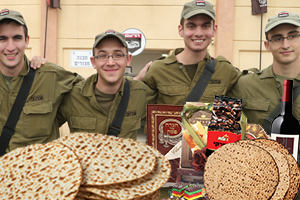
Throughout ancient and modern history, the Jewish people have maintained a physical and spiritual attachment to Rachel’s Tomb.
Rachel’s Tomb, located in the northern outskirts of Bethlehem, about 400 yards south of Jerusalem, is the third holiest site in Judaism after the Temple Mount and the Tomb of the Patriarchs in Hebron. For the past 1,700 years, the site has been identified as the burial place of the Jewish matriarch, Rachel, and Jews were known to pray at the site for over the past 3,000 years. Rachel, the beloved wife of the patriarch Ya’akov, died during childbirth as the family was traveling to Hebron.
Rachel’s Tomb in the Hebrew Bible
According to Genesis 35:16-21, “They set out from Bayt-El; but when they were still some distance from Efrat; Rachel went into childbirth, and she had hard labor. When her labor was at its hardest, the midwife said to her, “Have no fear, for it’s another boy for you.” But as she breathed her last –as she was dying– she named him Ben-Oni, but his father called him Benyamin. So Rachel died. She was buried on the road to Efrat — now Bethlehem. Over her grave Ya’acov set up a pillar, it is the pillar at Rachel’s grave to this day.”
Whenever the Jewish people faced sorrows, throughout the generations, they would traditionally pray for Rachel to cry for them at Rachel’s Tomb, believing that her tears to G-d have special powers. Since she herself was childless for many years, many Jewish women visit her grave in order to pray to have children, although other members of the Jewish community who face troubles also visit her grave. Thus, as the third holiest shrine in Judaism, Jews across the Diaspora maintained a spiritual connection to Rachel’s Tomb over the centuries and paid for the holy sites upkeep.
According to Jewish tradition, the matriarch Rachel has always cried for her people whenever the Jews needed her. Ya’akov reportedly buried Rachel in Bethlehem, instead of in the Tomb of Patriarchs in Hebron, because he foresaw that his descendants would need her prayers en route to exile in Babylonia. Additionally, Yosef, Rachel’s eldest son, was the first Jew to pray by her grave. According to a Midrash, Yosef broke away from his captors temporarily en route to bondage in Egypt and cried out at her grave, ‘Mother, my mother who gave birth to me, wake up, arise and see my suffering.’ Rachel replied, ‘Do not fear. Go with them, and G-d will be with you.’”
As Jeremiah 31:15-17 states, “Rachel, weeping for her children, she refuses to be comforted for her children who are gone. Thus said Hashem: Restrain your voice from weeping, your eyes from shedding tears; for there is reward for your labor’ declares Hashem. ‘They shall return from the enemy’s land and there is hope for the future’ declares Hashem: ‘Your children shall return to their own country.’”
Historically, the Muslim world considered Rachel’s Tomb a site holy to Jews
Historically, the Muslim world considered Rachel’s Tomb a site holy to Jews. According to a report written by the Jerusalem Center for Public Affairs, the sixteenth century Arab historian Mujir Al Din wrote that Rachel’s Tomb was a Jewish holy place. He recorded that Rachel’s Tomb was built with “eleven stones and covered with a cupola which rests on four pillars, and every Jew passing writes his name on the monument.” The same JCPA report declares that in 1830, the Ottoman Turkish authorities decreed that Rachel’s Tomb was a Jewish holy site, proclaiming, “the tomb of esteemed Rachel, the mother of our Lord Joseph…they (the Jews) are accustomed to visit it from ancient days; and no one is permitted to prevent them or oppose them (from doing) this.” Another Ottoman decree, dated 1831, orders that all obstacles be removed that were in place that interfered with members of the Jewish community that sought to visit Rachel’s Tomb.
In 1615, Mohammad, Pasha of Jerusalem, had rebuilt Rachel’s Tomb on behalf of the Jewish people. In 1841, Jewish caretakers were given exclusive ownership of the place. And in 1845, the entire Rachel’s Tomb compound was redone with the permission of the Turkish authorities by Moses Montefiore. A UN paper from 1949 that documents holy places in Palestine also lists Rachel’s Tomb as a Jewish holy site. Incidentally, it does not list it as a Muslim holy site. Recently Rachel’s tomb has come under attack physically by Arab rioters as well as culturally by anti-semitic historical revisionists who falsely claim Rachel’s tomb was also a mosque.
Featured in: http://www.jewishpress.com/blogs/united-with-israel/rachels-tomb-a-jewish-holy-site-since-ancient-times/2013/05/22/
By Rachel Avraham, staff writer for United With Israel
Send Passover Packages to Needy Israeli Soldiers - Bring Them Joy!
We are honored to thank the young men and women of the IDF who risk their lives every day to protect the citizens of Israel. Since October 7th, soldiers have been on the battlefield for months - many are hoping to come home for Passover.
Join us in sending Passover food packages (and personal notes) to Israeli soldiers and their families.
Many soldiers spend the Passover holiday with needy families back home. The soldiers greatly appreciate your love and concern. Bring them Passover joy!
CLICK HERE TO SEND YOUR PACKAGE AND NOTE TO ISRAELI SOLDIERS!



